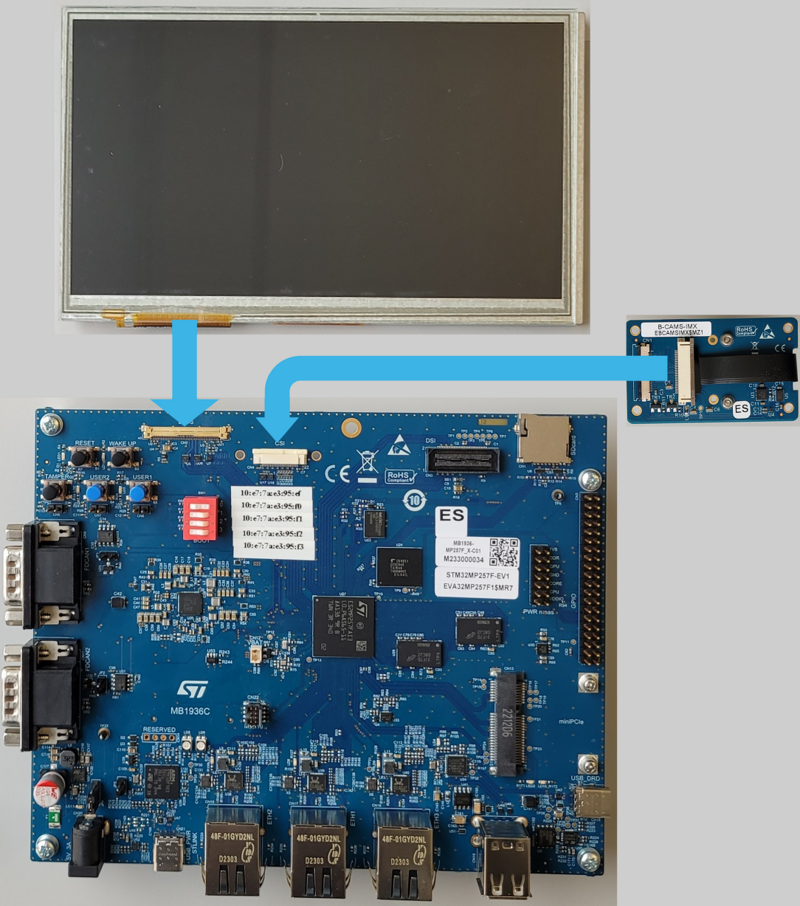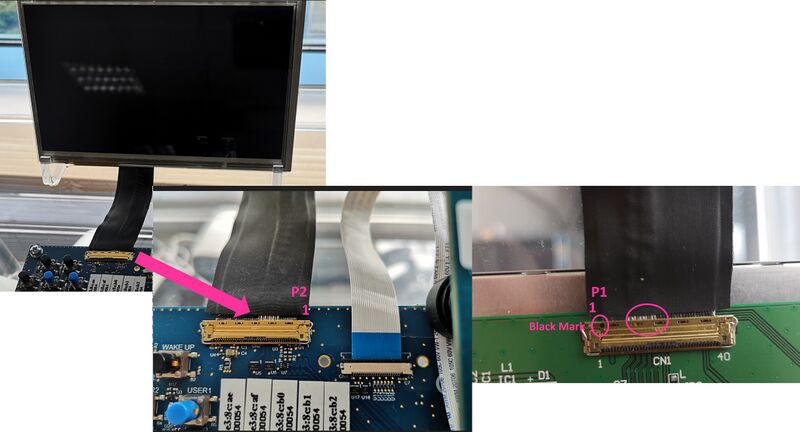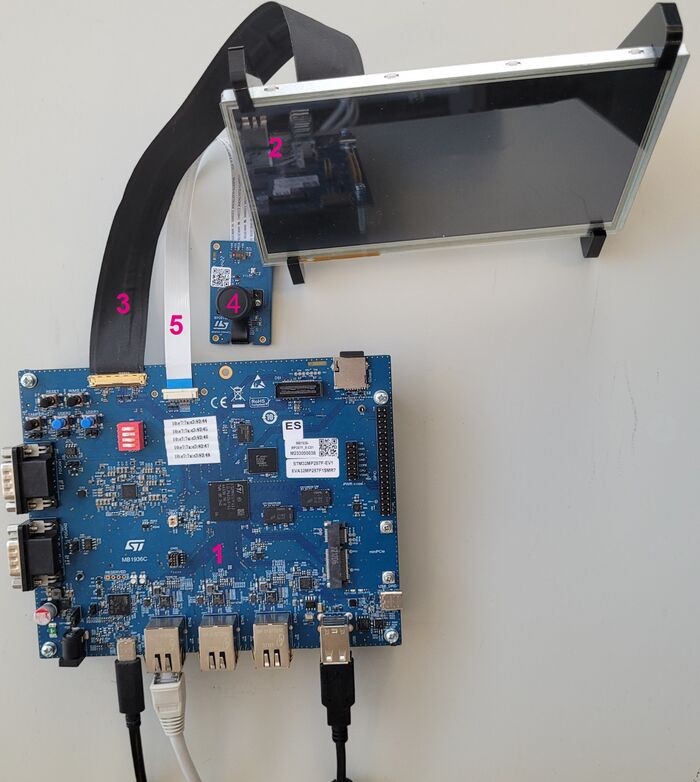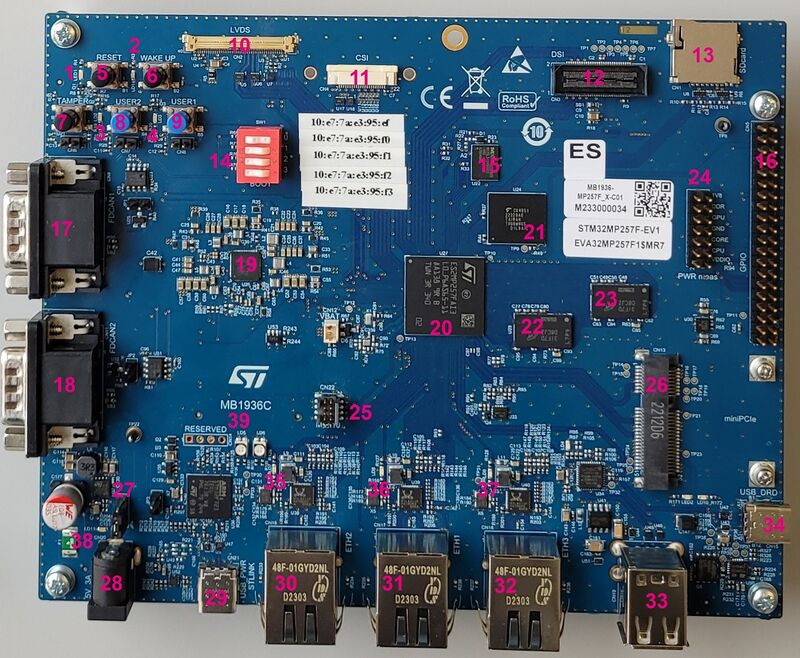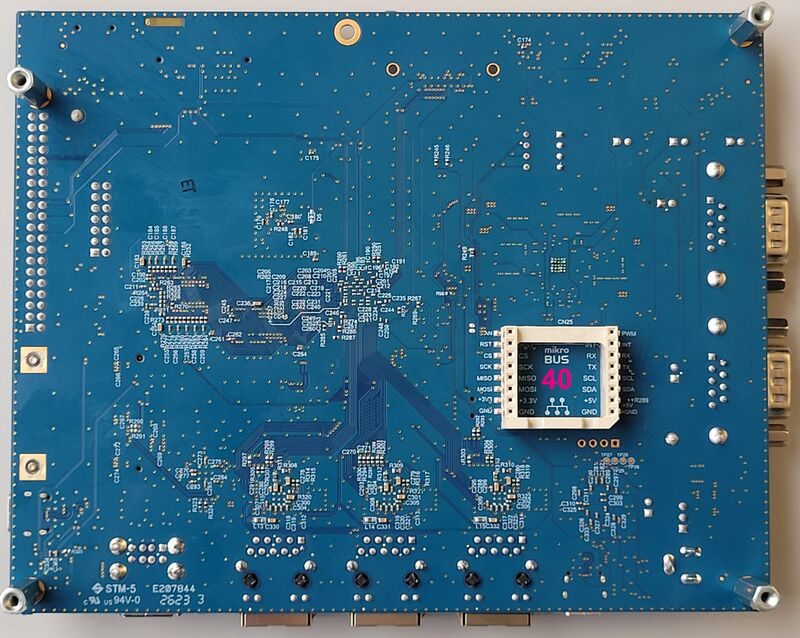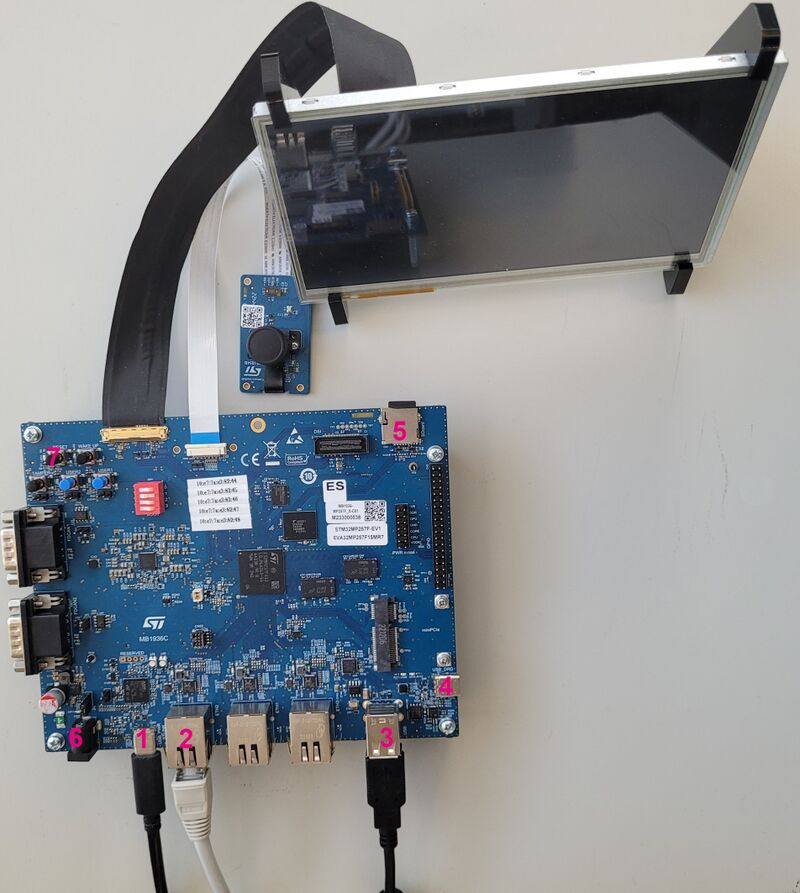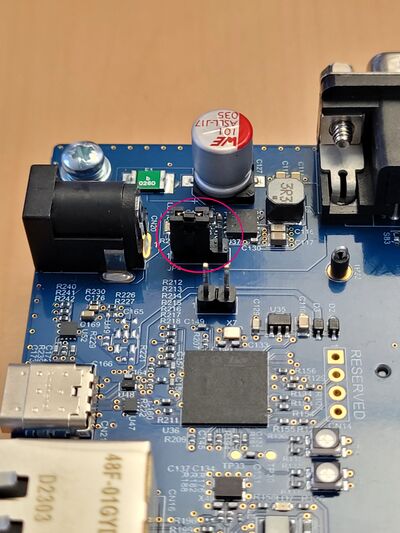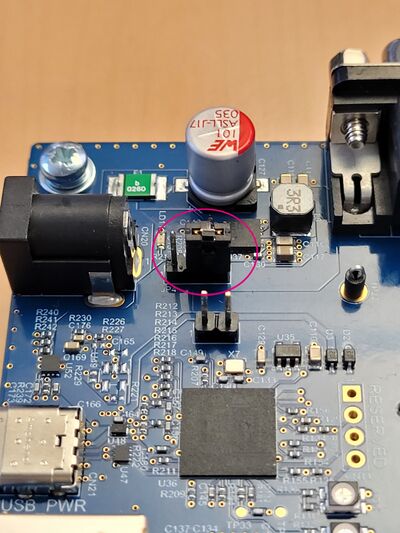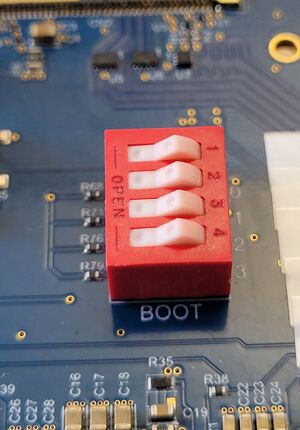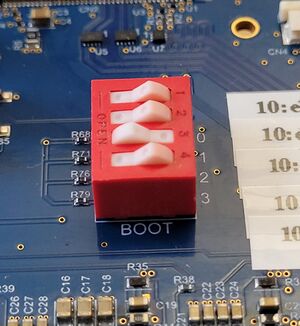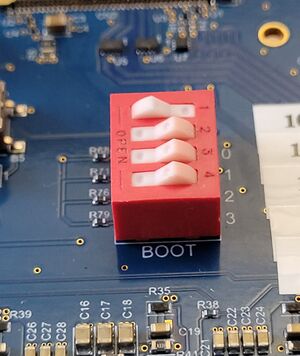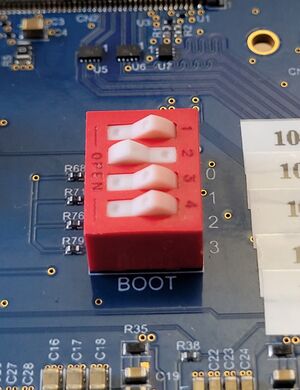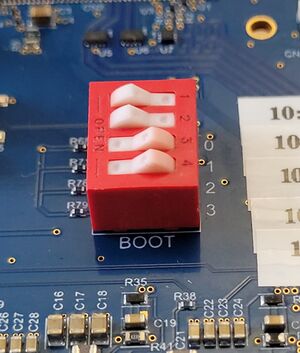This article provides an overview of STM32MP257x-EV1 Evaluation boards.
1. Article purpose[edit source]
This article briefly describes:
- How to assemble together the different elements provided in the commercial box
- What are the different components present on the boards
- How to connect the boards to external material
- How to configure the board for boot
yes right , the stlink is embeded , no access to RS232 UART }}
- How to select RS232 UART or ST-LINK/V2-1 connectors
- What are the configurations of the connectors pins
This article is valid for the STM32MP257F-EV1 ![]() Evaluation boards: the part numbers are specified in the STM32MP25 microprocessor part numbers article.
Evaluation boards: the part numbers are specified in the STM32MP25 microprocessor part numbers article.
2. Board assembly[edit source]
The STM32MP257x-EV1 Evaluation boards packages (STM32MP257F-EV1 ![]() ), completed by the B-CAMS-IMX package, include all the items listed below.
), completed by the B-CAMS-IMX package, include all the items listed below.
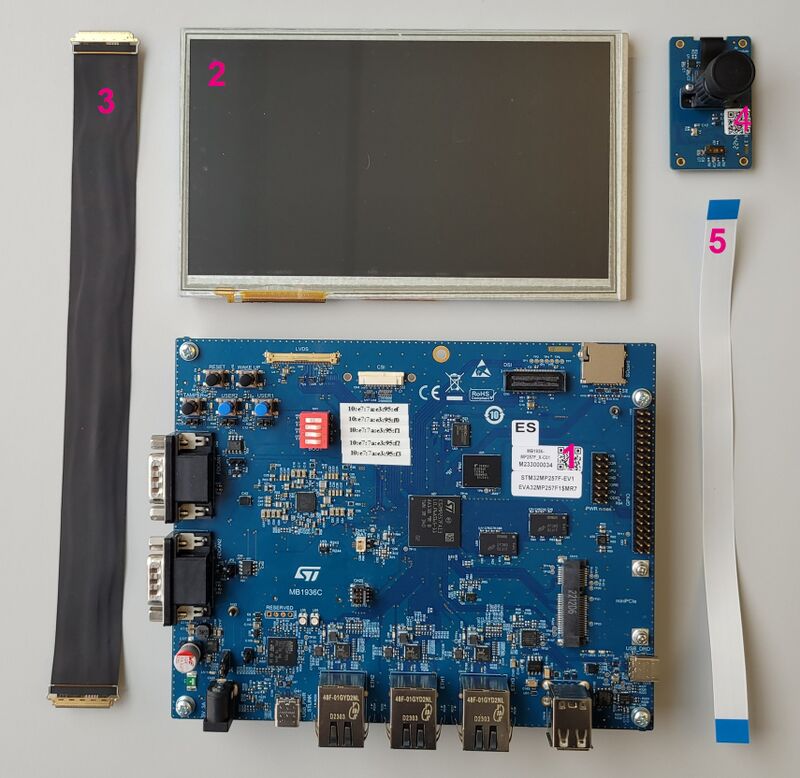
| Position | Description |
|---|---|
| 1 | MB1936 main board |
| 2 | 7” LVDS WSVGA display with touch panel (EDT ETML0700Z9NDHA panel) |
| 3 | LVDS display cable |
| 4 | MB1854 board AI camera (not part of STM32MP257x-EV1 Evaluation boards packages , provided via B-CAMS-IMX package) |
| 5 | camera board FFC (not part of STM32MP257x-EV1 Evaluation boards packages, provided via B-CAMS-IMX package) |
2.1. How to connect LVDS display to MB1936[edit source]
- Check the above cable orientation thanks to the black mark and the white twisted pairs.
- Find the LVDS port on STM32MP257x-EV1 Evaluation board (CN2) and the one on the display (CN1). One cable is provided in the STM32MP257x-EV1 Evaluation board box.
- On each port, insert the cable as described:
2.2. STM32MP257x-EV1 Evaluation board assembled[edit source]
3. Board overview[edit source]
| Position | Description | Position | Description |
|---|---|---|---|
| 1 (LED1) | User LED (blue) | 2 (LD1) | User LED (red) |
| 3 (LD2) | User LED (orange) | 4 (LD3) | User LED (green) |
| 5 (B1) | RESET button | 6 (B2) | WAKE UP button |
| 7(B3) | TAMPER button | 8 (B4) | USER2 button |
| 9 (B5) | USER1 button | 10 (CN2) | LVDS connector |
| 11(CN4) | CSI connector | 12(CN3) | DSI connector |
| 13 (CN1) | microSD card connector | 14 (SW1) | Boot mode selection |
| 15 (U22) | S-NOR 512Mb | 16 (CN5) | GPIO Expansion connector |
| 17 (CN9) | FDCAN1 | 18 (CN11) | FDCAN2 |
| 19 (U26) | STPMIC25 | 20 (U27) | STM32MP257 |
| 21 (U24) | eMMC 4GB | 22 (U29) | DDR4 2GB |
| 23(U28) | DDR4 2GB | 24 (CN10) | PWR measurements connector |
| 25 (CN22) | MIPI10 connector | 26 (CN13) | Mini-PCIe connector |
| 27 (JP4) | Power Jumper | 28 (CN20) | 5V/3A Power Supply Jack |
| 29 (CN21) | USB Power – ST-LINK TypeC | 30 (CN16) | ETHERNET 2 / PHY ETH2 |
| 31 (CN17) | ETHERNET 1 / PHY ETH1 | 32 (CN18) | ETHERNET 3 / PHY ETH3 |
| 33 (CN19) | Dual USB Host TypeA | 34 (CN15) | USB2.0 DRD TypeC |
| Position | Description |
|---|---|
| 35(CN35) | mikroBUS connector |
4. Board connection[edit source]
The connections shown in the picture below are the ones recommended to start with the STM32MP257x-EV1 Evaluation boards. As shown in the board overview, other connectors are available for this board (for example CAN).
5. Switches and jumpers[edit source]
Most of default settings of the switches and jumpers shall be kept as set in the commercial box.
There are 2 main exceptions:
- the jumpers related to power
- the switches related to boot
The sections below detail the main boot switches and the power jumpers.
5.1. Power jumper[edit source]
According to the positions presented in the table below, the power jumper (JP4) allows either the supply of the MB1936 board with :
- a 5V/3A power supply unit (not provided with the STM32MP25 Evaluation board pack) on the jack CN20,
- a USB Power TypeC CN21 (USB cable not provided with the STM32MP25 Evaluation board pack).
| Jumper | Setting | Configuration |
|---|---|---|
| JP4 | JP[1-2] | Select the USB Power TypeC CN21 as main board supply - USC typeC cable |
| JP4[2-3] | Select the 5V/3A Power Supply Unit on jack CN20 as main board supply |
[edit source]
The STM32MP257x-EV1 Evaluation boards can boot from different Flash devices (microSD, eMMC, S-NOR...); using the microSD card is recommended.
| Boot mode | Boot 3 | Boot 2 | Boot 1 | Boot 0 |
|---|---|---|---|---|
| UART/USB | 0 | 0 | 0 | 0 |
| microSD card | 0 | 0 | 0 | 1 |
| eMMC | 0 | 0 | 1 | 0 |
| Development | 0 | 0 | 1 | 1 |
| S-NOR | 0 | 1 | 0 | 0 |
'0' is considered when switch is pushed in OPEN position and is ‘1’ otherwise.
The boot related switches (SW1 on the board overview picture) must be configured as illustrated by one of the following pictures:
6. GPIO mapping[edit source]
6.1. GPIO expansion connector[edit source]
The pins of the GPIO expansion connector (CN5 on the board overview picture) are described in the following table:
| Function | STM32 pin | Pin | Pin | STM32 pin | Function |
|---|---|---|---|---|---|
| 3V3 | - | 1 | 2 | - | 5V |
| GPIO2 / I2C8_SDA | PZ3 | 3 | 4 | - | 5V |
| GPIO3 / I2C8_SDL | PZ4 | 5 | 6 | - | GND |
| GPIO4 / MCO1 | PF11 | 7 | 8 | PF13 | GPIO14 / USART6_TX |
| GND | - | 9 | 10 | PF14 | GPIO15 / USART6_RX |
| GPIO17 / USART6_RTS | PG5 | 11 | 12 | PA4 | GPIO18 / SAI2_SCKA |
| GPIO27 / SDMMC3_D3 | PC3 | 13 | 14 | - | GND |
| GPIO22 / SDMMC3_CK | PB13 | 15 | 16 | PG1 | GPIO23 / SDMMC3_CMD |
| 3V3 | - | 17 | 18 | PB14 | GPIO24 / SDMMC3_D0 |
| GPIO10 / SPI3_MOSI | PB8 | 19 | 20 | - | GND |
| GPIO9 / SPI3_MISO | PB10 | 21 | 22 | PI0 | GPIO25 / SDMMC3_D1 |
| GPIO11 / SPI3_SCK | PB7 | 23 | 24 | PH11 | GPIO8 / SPI3_NSS |
| GND | - | 25 | 26 | PF10 | GPIO7 |
| I2C2_SDA | PB4 | 27 | 28 | PD12 | I2C2_SCL |
| GPIO5 / TIM8_CH4 | PJ4 | 29 | 30 | - | GND |
| GPIO6 / TIM12_CH2 | PD13 | 31 | 32 | PE5 | GPIO12 / TIM10_CH1 |
| GPIO13 / TIM8_CH1 | PJ5 | 33 | 34 | - | GND |
| GPIO19 / SAI2_FSA | PJ3 | 35 | 36 | PF15 | GPIO16 / USART6.CTS |
| GPIO26 / SDMMC3_D2 | PI11 | 37 | 38 | PA5 | GPIO20 / SAI2_SDA |
| GND | - | 39 | 40 | PA0 | GPIO21 / SAI2_SDB |
6.2. User buttons and LEDs[edit source]
The GPIO assignments for the user buttons and LEDs are described in the following table. Refer to LEDs and buttons on STM32 MPU boards article to get information on the functional mapping for each one.
| LED color and label | GPIO |
|---|---|
| Green LD3 (*) | PD8 |
| Red LD1 (*) | PH4 |
| Orange LD2 | PJ6 |
| Blue LED1 | PJ7 |
| Button | GPIO |
|---|---|
| USER1 | PD2 |
| USER2 | PG8 |
7. References[edit source]
